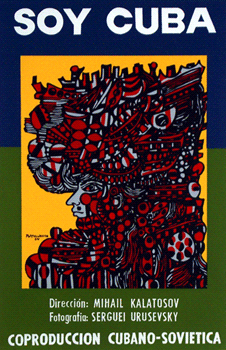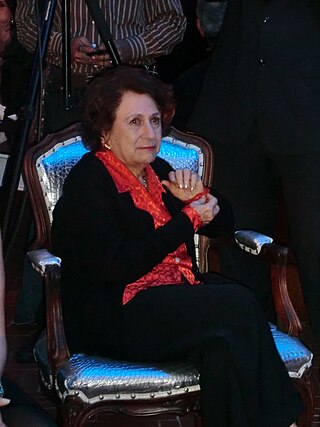
The Sucre State is one of the 23 states of Venezuela. The state capital is Cumaná city. Sucre State covers a total surface area of 11,800 km2 (4,600 sq mi) and, as of the 2011 census, had a population of 896,921. The most important river in the state is the Manzanares River.

I Am Cuba is a 1964 film directed by Mikhail Kalatozov at Mosfilm. An international co-production between the Soviet Union and Cuba, it is an anthology film mixing political drama and propaganda.

La Reine Margot is a 1994 historical romantic drama film directed by Patrice Chéreau, from a screenplay he co-wrote with Danièle Thompson, based on the 1845 historical novel of the same name by Alexandre Dumas. The film stars Isabelle Adjani, Daniel Auteuil, Jean-Hugues Anglade, Vincent Perez, and Virna Lisi. An abridged version of the film was released as Queen Margot in North America, and in the United Kingdom under its original French title.

The Araya Peninsula is a peninsula on the Caribbean Sea, located in Sucre State, northern Venezuela.

Mikhail Konstantinovich Kalatozov, born Mikheil Kalatozishvili, was a Soviet film director of Georgian origin who contributed to both Georgian and Russian cinema. He is most well known for his films The Cranes Are Flying and I Am Cuba, winning the Palme d'Or for the former at the 1958 Cannes Film Festival. In 1969, Kalatozov was named a People's Artist of the USSR.

The Silent World is a 1956 French documentary film co-directed by Jacques Cousteau and Louis Malle. One of the first films to use underwater cinematography to show the ocean depths in color, its title derives from Cousteau's 1953 book The Silent World: A Story of Undersea Discovery and Adventure.

A Summer's Tale is a 1996 French romantic comedy-drama film written and directed by Éric Rohmer. It is the third film in his Contes des quatre saisons series, which also includes A Tale of Springtime (1990), A Tale of Winter (1992), and Autumn Tale (1998). A Summer's Tale stars Amanda Langlet, Melvil Poupaud, Aurélia Nolin and Gwenaëlle Simon.

Margot Benacerraf was a Venezuelan film director. She studied at the Institut des hautes études cinématographiques in Paris and is best known for her 1959 award-winning film Araya.

Annemarie Jacir is a Palestinian filmmaker, writer, and producer.

The 6th Cannes Film Festival was held from 15 to 29 April 1953. The Grand Prix of the Festival went to The Wages of Fear by Henri-Georges Clouzot.

The 11th Cannes Film Festival was held from 2 to 18 May 1958. The Palme d'Or went to The Cranes are Flying by Mikhail Kalatozov.

The 12th Cannes Film Festival was held from 30 April to 15 May 1959. The Palme d'Or went to the Orfeu Negro by Marcel Camus. The festival opened with Les Quatre Cents Coups, directed by François Truffaut and closed with The Diary of Anne Frank, directed by George Stevens.

Salt of this Sea is a 2008 Palestinian film directed by Annemarie Jacir and was an Official Selection of the Cannes International Film Festival in 2008. It is Palestine's submission to the 81st Academy Awards for the Academy Award for Best Foreign Language Film. The film stars Palestinian-American poet Suheir Hammad as Soraya, an American-born Palestinian woman, who heads to Israel and Palestine on a quest to reclaim her family's home and money that were taken during the 1948 Arab-Israeli War. A young Saleh Bakri also stars in the film in his first role in an Arab film.

European Venezuelans or White Venezuelans are Venezuelan citizens who self-identify in the national census as white, tracing their heritage to European ethnic groups. According to the official census report, although "white" literally involves external caucasoid features such as fair skin, hair, and eyes, among others, the term "white" has been used in different ways in different historical periods and places, and so its precise definition is somewhat confusing.
Andrés Rodríguez de Villegas (1580–1631) was a Spanish soldier who served as governor and captain-general of the Province of Isla Margarita, Venezuela (1619–1626) and as governor of Spanish Florida (1630–1631).

The cinema of Venezuela is the production and industry of filmmaking in Venezuela. Venezuelan cinema has been characterised from its outset as propaganda, partially state-controlled and state-funded, commercial cinema. The nation has seen a variety of successful films, which have reaped several international awards. Still, in terms of quality, it is said that though "we can point to specific people who have made great films in Venezuela [and] a couple of great moments in the history of Venezuelan cinema, [...] those have been exceptions". In the 21st century, Venezuelan cinema has seen more independence from the government, but has still been described as recently as 2017 to be at least "influenced" by the state.
Luis Armando Roche was a Venezuelan film director, screenwriter, producer and director of theatre and opera. In 1999, Roche won the most important prize of cinema in his country, the National Film Award of Venezuela.

The National Cinematheque of Venezuela is a Venezuelan public institution founded on May 4, 1966, by Margot Benacerraf and since then is dedicated to archiving, preserving and presenting film archives in Venezuela. It holds more than 85,000 films, 30,000 photographs, 420 movie posters, 400 scripts and 30,000 film books and magazines.

The Araya and Paria xeric scrub (NT1301) is an ecoregion in Venezuela that stretches along the Caribbean coast to the west of Trinidad, and that includes Margarita Island and some smaller islands. The ecoregion includes dune herbs, dry thorn scrubs and deciduous forests. The mountains on Margarita Island hold montane forests similar to those in the mainland coastal range. The beaches are used for breeding by sea turtles. Some endemic bird species are threatened with extinction by illegal capture for the pet trade. Deforestation and over-grazing by goats are also problems.
Reverón is a 1952 Venezuelan documentary film written and directed by Margot Benacerraf. The camera and photography was by Boris Doroslovacki, music by Guy Bernard and Venezuelan folklore, and narrated by Carlos Augusto León.

















